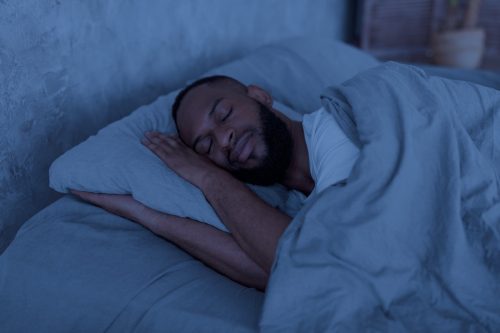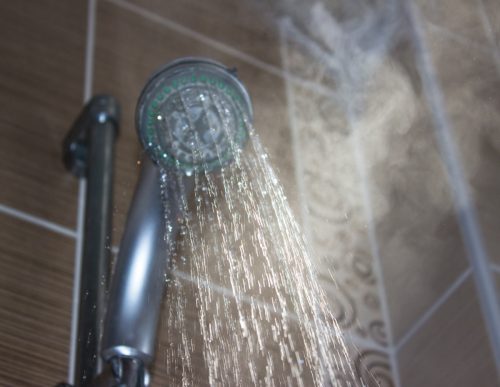What Is Pink Noise and How Does It Help You Sleep?

If you’re into ambient noises and relaxation, you’ve come to the right place. Most people have heard of white or brown noise, but are you familiar with pink noise? Even if the name doesn’t ring a bell, you’ve probably heard it more times than you think.
Make your sleep routine a little more colorful and learn all about pink noise, its surprising benefits, and the science behind its calming frequency from experts. It’s a soothing sound hack that might just revolutionize your sleep.
RELATED: 6 Bedtime Routines That Will Help You Sleep Through the Night.
What Is Pink Noise?

Although pink noise sounds a lot like the name of an obscure indie band, it’s not—but it is just as unique and pleasant to listen to. Pink noise is actually a constant sound that includes all the audible frequencies to the human ear. It rests in the lower sound waves, which can be incredibly soothing to listeners.
Some frequencies are named after colors that are used to represent the noise’s level of frequency on the sound spectrum. Pink noise has a random assortment of every audible frequency “that mixes different pitches with a twist,” says Korina Burkhard, a sleep expert at Dozy. “Pink noise gently diminishes higher frequencies and emphasizes lower frequencies.”
It can often sound like a low and deep rumble. A few examples of pink noise include:
- Rushing waterfalls
- Rivers
- Strong winds
- Heavy rainfall
- Fans
- Humidifiers
- Rustling of leaves
- Air conditioners
“Pink noise is like turning down the treble on the static noise to make the lower tone louder and, hence, more relaxing,” Burkhard says. “Pink noise feels more pleasant and well-balanced.”
RELATED: 6 Reasons You Feel Tired But Can’t Fall Asleep, According to Doctors.
What Are the Benefits of Using Pink Noise for Sleep?

Pink noise can positively impact your brain and be an extremely beneficial tool during your bedtime routine.
“The benefits of using pink noise include ease of falling asleep,” Burkhard says. “The pink noise masks the bothersome and interruptive background sounds, making it easy to fall asleep. Also, it improves sleep quality because the brain waves slow down in sync with the soundtrack from the pink noise. It stabilizes sleep patterns, which improves your sleep quality as you fall asleep easier, deeper, and longer.”
Its ability to drown out unwanted noise around you could also help lower your anxiety and reduce stress as well.
Beyond that, pink noise is a big help if you’re forgetful. According to a 2017 study published in Frontiers in Human Neuroscience, people who listened to brief bursts of pink noise in intervals while they slept reported improved memory and recall ability.
Sure, pink noise can be a soothing tool for anyone looking for a good night’s rest, but according to Claire Law, a relational psychotherapist, there are a few groups who stand to benefit the most from this ambient sound:
- People who are sensitive to noise/light sleepers
- Hospital patients (per a sound study, hospital patients were reported to fall asleep 40 percent faster when exposed to pink noise)
- Overthinkers
- People who are stressed
- People who have an inconsistent sleep schedule/work nights
- People with insomnia
“Many of my clients with conditions like insomnia, hyperarousal, or ADHD report feeling their minds quiet and their bodies relax when exposed to pink noise,” says Rychel Johnson, a mental health expert. So, whether you struggle with sleep or calming your mind, pink noise could be a good option to try out.
RELATED: 20 Doctor-Approved Tips to Get a Full Night’s Sleep Tonight.
How Does Pink Noise Affect Your Brain?

The sound of pink noise can impact listeners because it taps into our brains.
“By reducing our brain’s unconscious auditory monitoring duties, pink noise seems to facilitate slower brainwave activity and deepen sleep stages like non-REM sleep,” Johnson says. “The even balance of high and low frequencies may also trigger physiological responses like slowed heart and respiratory rates.”
According to Caleb Backe, a sleep expert for Maple Holistics, “This is a process known as neural entrainment, when our brain activity mimics what is happening around us in terms of sight, noise, and touch.”
Burkhard says there is a theory that suggests pink noise influences brainwave patterns and “synchronizes brain waves in the slower delta and theta wave ranges, which help with deep sleep.”
Pink noise also increases the fluctuations within the brain’s alpha and delta frequency ranges, which are linked to relaxation, Law says.
RELATED: 4 Simple Sleep Habits That Help You Live Longer, New Research Shows.
What Is White Noise?

White noise is super famous in the ambient noise community, but it can be difficult to describe. To better understand pink noise, it’s important to know what this sound is as well. White noise has a very high-pitched frequency compared to pink noise, so think of the sound of a vacuum or television static.
“The frequencies from white noise blast at the same volume, which can be a little harsh for some,” Burkhard says.
White noise includes all the frequencies across the sound spectrum, which rest at the same flat level of intensity. And while some people find it jarring, others use it to relax their mind and even treat ADHD symptoms.
“While [both white and pink noise] are able to mask background noises and encourage a deeper sleep, pink noise creates warmer, deeper sounds which are soothing and gentle,” Backe says.
What Is Brown Noise?

When it comes to ambient noise fame, brown noise usually comes in second. Brown noise (also known as red noise) is a lot like pink noise, as it includes deeper and lower frequencies that sound a lot like a rumbling.
Examples of brown noise include washing machines, air conditioners, or running showers. People also use this sound to focus, sleep, and soothe anxiety.
RELATED: 10 Science-Backed Ways to Calm Down Fast.
Are There Any Tips for Using Pink Noise?

Pink noise can be a wellness tool, so knowing how to use it safely and correctly can do wonders for your mind and body. When using this ambient noise, Law and Burkhard suggest the following:
- Introduce it to your bedtime routine slowly. Try one to two nights per week for short periods.
- Keep the volume at a low 50 decibels and under.
- Use it with other relaxation techniques like deep breathing or meditation.
- Place the pink noise source away from your bed and near the window, door, or across the room, as this helps minimize external noises.
Keep in mind, if you’re using pink noise to go to bed, it’s essential to prioritize good sleep practices to maximize its effectiveness as well. Law suggests incorporating these tips into your rest routine:
- Lock in a consistent sleep/wake schedule.
- Create an ideal sleep environment for bedtime that’s just right for you (cool, dark, quiet, etc.)
- Avoid/limit alcohol, caffeine, and electronics before bed. According to the Journal of Applied Psychology, screens emit a blue light that suppresses melatonin production, which is a vital hormone for falling asleep.
- Add stress management techniques like mediation, exercise, and eating healthy snacks and meals.
But if you find that using pink noise doesn’t give you your desired results for handling your sleep issues, “feel free to consult a medical professional to rule out any underlying conditions,” Law says. “I always remind my patients that sometimes it takes a little troubleshooting to find the right sleep aids and routine.”
RELATED: The 6 Best Meditation Styles for Relieving Stress If You’re Over 50.
What Are the Disadvantages to Pink Noise?

Pink noise is typically harmless, but like anything, it can be problematic when used incorrectly or excessively.
“There is a risk of hearing damage if you play the pink noise too loudly over a long period of time,” Burkhard cautions. “There is also a challenge of the limited scientific study into pink noise, which is needed to provide a holistic answer and ascertain its safety over a long period.”
Burkhard also advises against becoming too reliant on pink noise, as overuse can reduce its effectiveness or make you completely dependent on it to go to sleep.
“But for most individuals, pink noise can provide a safe, portable, and non-habit-forming way to naturally ease into quality sleep,” Johnson says.
RELATED: Feng Shui Bedroom Tips for Better Sleep.
Where Can I Listen to Pink Noise?

Thankfully, pink noise isn’t hard to find. There are several ways you can access it, whether that’s naturally or through a device. Here are a few place to get your pink noise fix:
Go online
The internet has literally everything, so if you’re not ready to commit to an app or device, fire up YouTube or a search engine and look up the sound there. You’ll be able to find hours of pink noise, and most importantly, it’s free.
Download an app
When it comes to pink noise, there’s an app for that. So, if you’re looking for an easy way to listen to pink noise, look no further than your phone.
For more elaborate features for your ambient noise needs, prepare to pay extra money in app costs. But if you already have music-playing apps like Spotify or Apple Music, pink noise should be available there as well.
Wait for nature
If you want a more organic option for listening to pink noise, natural resources are always a good choice. Take a trip to the beach and listen to the waves crash against the shore, or slowly walk through a pile of leaves to hear them rustling. Listening to heavy downpours of rain can also become a relaxing pink noise experience.
Get a sound machine
Getting a sound machine is the equivalent of going steady, so if you’re ready to commit pink noise to your bedtime routine, this is a solid option. For those who already have a white noise machine, see if it has a pink noise setting first before shopping for a new one. These devices usually range between $20 and $130, but prices can climb even higher depending on the level of quality you’re looking for.
Remember, when choosing a machine, make sure you’re getting the most bang for your buck. Check out the volume control and how low and loud it gets. You also want to make sure it has a sleep timer to avoid the sound playing throughout the entire night. While most are usually built-in, it never hurts to double-check.
Most sound machines offer white noise, but if you want to diversify your ambient sound listening experience so you don’t become numb to one color, make sure it provides other sounds.
RELATED: 10 Ways to Feel Calm and Happy (That Aren’t Meditation).
What Are Other Color Noises?

The sound spectrum is very colorful and goes beyond white, brown, and pink. Learn more about these lesser-known color of noises:
Blue noise
Blue noise is considered the opposite of brown noise because of its high frequency. Its intensity increases and often sounds more shrill than white noise. It has much more treble than base and is often likened to the sound of a hissing water spray.
Violet noise
Violet noise is a lot like blue noise, as it becomes louder as the frequency increases. It’s higher pitched and sounds almost like a sizzle or hissing. It can also be used to treat tinnitus.
Gray noise
With gray noise, all of its frequencies have the same intensity. It is more intense in higher and lower frequencies and not so much in the middle.
RELATED: 6 Bedtime Habits of People Who Never Get Sick.
What Are More Helpful Sleep Tips to Add to Your Bedtime Routine?

Pink noise can play a significant role in your rest, but setting a solid sleep foundation can go a long way. In addition to listening to this ambient noise, here are a few ways to maximize your sleep.
Avoid napping during the day
Power naps may be a big help during the day, but they can mess up your nighttime sleep schedule. Make an effort to stay awake throughout the day and if you work in the evenings, try to squeeze in a late-day nap, so you’re not completely exhausted.
Close the book on your stresses before bed
How many of us have been kept up by stressful situations in our lives? Although some of those issues can’t be solved before bedtime, managing them could help you shift your mind to better space. Try writing your worries down or making a plan on how to tackle the issue before going to bed.
Go outside during the day
Getting at least 30 minutes of natural sunlight can regulate your circadian rhythm. Your body’s understanding of time is affected by light exposure, so adding it to your daytime routine can help make your nighttime one better.
RELATED: I’m a Sleep Scientist and These Are the Top 5 Unhealthy Habits I Avoid.
Wrapping Up
Bedtime can be a battle, but there’s nothing wrong with adding a little help. Pink noise is filled with stable and soothing frequencies, which could be just what you need to debug your sleep issues. The next time you’re trying to relax or mellow out, think about making pink noise your sound solution.
- Source: Frontiers in Human Neuroscience: Acoustic Enhancement of Sleep Slow Oscillations and Concomitant Memory Improvement in Older Adults
- Source: Frontiers in Neurology: Broadband Sound Administration Improves Sleep Onset Latency in Healthy Subjects in a Model of Transient Insomnia
- Source: International Journal of Environmental Research and Public Health: The Effects of White Noise on Attentional Performance and On-Task Behaviors in Preschoolers with ADHD
- Source: Journal of Applied Psychology: Blue light from light-emitting diodes elicits a dose-dependent suppression of melatonin in humans
- Source: CDC: Coping With Stress
- Source: Mayo Clinic: Sleep tips: 6 steps to better sleep